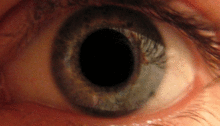Pupillary response

Pupillary response is a
A constriction response (

A dilation response (

The responses can have a variety of causes, from an involuntary reflex reaction to exposure or inexposure to light—in low light conditions a dilated pupil lets more light into the eye—or it may indicate interest in the subject of attention or arousal, sexual stimulation,[3] uncertainty,[4] decision conflict,[5] errors,[6] physical activity[7] or increasing cognitive load[8] or demand. The responses correlate strongly with activity in the locus coeruleus neurotransmitter system.[9][10][11] The pupils contract immediately before REM sleep begins.[12] A pupillary response can be intentionally conditioned as a Pavlovian response to some stimuli.[13]
Some humans have the ability to exert direct and voluntary control over their iris sphincter muscles and dilator muscles, granting them the ability to dilate and constrict their pupils on command, regardless of lighting condition and/or eye accommodation state.[14] However, this ability is very rare, and its potential use or advantages are unclear.
The latency of pupillary response (the time in which it takes to occur) increases with age.[15]
In ophthalmology, intensive studies of pupillary response are conducted via videopupillometry.[16]
Anisocoria is the condition of one pupil being more dilated than the other.


| Constriction (Parasympathetic) | Dilation (Sympathetic) | |
|---|---|---|
| Muscular mechanism | Relaxation of iris dilator muscle, activation of iris sphincter muscle | Activation of iris dilator muscle, relaxation of iris sphincter muscle |
| Cause in pupillary light reflex | Increased light | Decreased light |
| Other physiological causes | Accommodation reflex | Fight-or-flight response, sexual arousal |
| Corresponding non-physiological state | Miosis | Mydriasis |
See also
- Cycloplegia
- Dilated fundus examination
- Iris sphincter muscle
- Pupillary light reflex
- Pupillary reflex
- Pupillometry
- Pupilometer
References
- PMID 7326222.
- PMID 1363080
- S2CID 12857616.
- PMID 22660479.
- S2CID 4960140.
- S2CID 220044505.
- PMID 36153491.
- S2CID 22762466.
- S2CID 535645.
- PMID 26711118.
- PMID 24510607.
- ^ Lowenstein O, Feinberg R, Loewenfeld IE (April 1963). "Pupillary Movements During Acute and Chronic Fatigue: A New Test for the Objective Evaluation of Tiredness" (PDF). Investigative Ophthalmology. 2 (2). St. Louis: C.V. Mosby Company: 138–157. Archived from the original (PDF) on 2012-03-19.
- )
- ISSN 0167-8760.
- OCLC 84657376. Archived from the original(PDF) on 2012-03-20.
- PMID 5439164.
